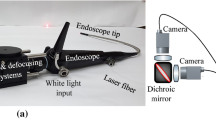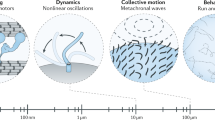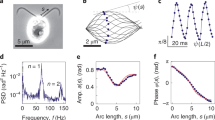Abstract
A REVIEW of the present knowledge of cilia has been made by Rivera1. Various methods have been used for estimating the frequency and testing the effects of different substances on ciliary beat. A common method has been to drop particles such as coal and seed on ciliated epithelium and to count the time required for the particle to travel a certain distance2. This method gives a rough value for the speed of the cilia, but other factors such as viscosity and thickness of the mucous layer interfere severely with the results. The ‘Flimmeruhr’3 and the ‘Cilioscribe’4 were other methods described by earlier authors. With the aid of the Leitz Ultra-Pak vertical light microscope better measuring methods have been developed. Cinematographic recording and stroboscopy combine greater accuracy with less traumatic effect on the cilia when measuring. Dalhamn examines the two methods systematically5and describes a cinematographic equipment which makes it possible to determine quite small changes in frequency of ciliary beat in living rabbits6. The strobosoopic method is rather severely criticized and not recommended by this author. Microscopic counting of the vibratory activity of small ciliated epithelium fragments in tissue cultures is another method which has been used for testing the influence of various agents7. A disadvantage of the cinematographic method is that the results are not available immediately, and, as continuous measurement is not possible, minor effects of substances tested might be overlooked.
This is a preview of subscription content, access via your institution
Access options
Subscribe to this journal
Receive 51 print issues and online access
$199.00 per year
only $3.90 per issue
Buy this article
- Purchase on Springer Link
- Instant access to full article PDF
Prices may be subject to local taxes which are calculated during checkout
Similar content being viewed by others
References
Rivera, Jose A., Cilia, Ciliated Epithelium and Ciliary Activity Intern. Ser. Mono. Pure and App. Biol. (Pergamon Press, 1962).
Viktorow, K., Acta Otolaryngologica, 21, 61 (1934).
Engelmann, T. W., Pflügers Arch. ges. Physiol., 15, 493 (1877).
Inchley, O., J. Physiol., 54 (1921).
Dalhamn, T., Acta Physiol. Scand., 36, Supp. 123 (1956).
Dalhamn, T., Acta Physiol. Scand., 49, 242 (1960).
Barski, G., Cornefert, F., and Wallace, R. E., Proc. Soc. Exp. Biol. Med., 100, 407 (1959).
Author information
Authors and Affiliations
Rights and permissions
About this article
Cite this article
DALHAMN, T., RYLANDER, R. Frequency of Ciliary Beat measured with a Photo-sensitive Cell. Nature 196, 592–593 (1962). https://doi.org/10.1038/196592a0
Issue Date:
DOI: https://doi.org/10.1038/196592a0
This article is cited by
-
Visualization and Detection of Ciliary Beating Pattern and Frequency in the Upper Airway using Phase Resolved Doppler Optical Coherence Tomography
Scientific Reports (2017)
-
Microscale imaging of cilia-driven fluid flow
Cellular and Molecular Life Sciences (2015)
-
Analysis of ependymal ciliary beat pattern and beat frequency using high speed imaging: comparison with the photomultiplier and photodiode methods
Cilia (2012)
-
An investigation into the effects of midazolam and propofol on human respiratory cilia beat frequency in vitro
Intensive Care Medicine (1998)
Comments
By submitting a comment you agree to abide by our Terms and Community Guidelines. If you find something abusive or that does not comply with our terms or guidelines please flag it as inappropriate.



